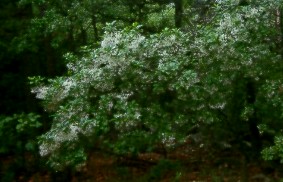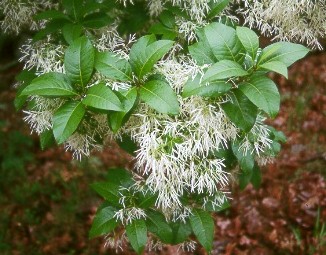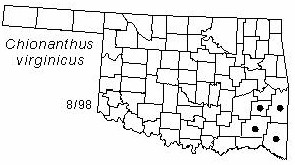

Shrub or small tree to 10 m (35 ft) tall. Crown narrow and oblong. Bark light gray to brown. Twigs orange-brown, gray with age, stout, pubescent. Leaves opposite, simple, oval to oblong; 10-20 cm (4-8 in) long, 2.5-10 cm (1-4 in) wide, glabrous, with hairs on the veins beneath, dark green above, paler beneath; cuneate at base, obtuse, acute or acuminate at apex, margins entire or wavy; petioles 1.2-2.5 cm (0.5-1 in) long, puberulent. Flowers numerous in panicles 10-15 cm (4-6 in) long with sessile, oblong bracts, pubescent pedicels, sepals small, persistent, green, glabrous; petals 4-6, white, linear, acute, about 2.5 cm (1 in) long; ovary 2-celled, ovoid; style short, 2-lobed; stamens 2, filaments short; flowers appear from March to June. Fruits drupes, 1.2-1.8 cm (1/2-3/4 in) long, oval to oblong, blue-black, glaucous, with 1-3 seeds about 8 mm (1/3 in) long, ovoid, brown; fruits mature August to October.
Distribution: Oklahoma, Arkansas, Texas, east to Florida, north to New Jersey. Rare in Oklahoma, limited to Ouachita Mountains.
Habitat: understory plant in streamside forests and mountains.
Comments: Chionanthus means "snow flower"; virginicus refers to the state of Virginia.
Horticulture: A popular ornamental due to its delicate, fragrant white flowers. Grancy grey-bread is a common cultivar. First cultivated in 1736. Last tree to produce leaves in spring. Seeds must be stratified at 41oF for one year. Fringe-tree can also be propagated by layering and grafting.
Medicinal uses: bark has been used as a diuretic or fever remedy.
NWI status: FACU, FAC+.
Distribution in Oklahoma: 
BACK
NEXT
RETURN TO INDEX
Last update: 9/9/99
 Go to Oklahoma Biological Survey Home Page
Go to Oklahoma Biological Survey Home Page
 Disclaimer
Disclaimer